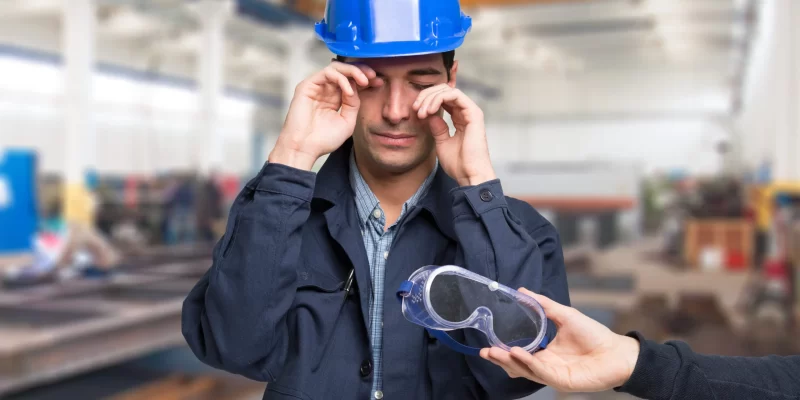
In industrial environments, protecting the eyes from various hazards is not just a requirement—it’s an absolute necessity. Industrial safety eyewear programs are designed to prevent injuries and protect the vision of workers exposed to various dangers, such as flying debris, chemical splashes, and harmful radiation. This comprehensive guide delves into the critical components of industrial safety eyewear programs, including industrial prescription safety eyewear, the costs involved, and the vital role of industrial safety goggles.
What Is an Industrial Eyes Safety Eyewear Program?
An industrial eyes safety eyewear program is a structured initiative implemented by companies to protect workers from eye-related injuries in hazardous environments. It involves the selection, provision, and monitoring of suitable eye protection equipment like safety glasses, goggles, and face shields.
Why Is Industrial Eye Protection Important?
Industrial settings are rife with dangers that can cause serious eye injuries. Ensuring proper eye protection can help reduce accidents, prevent vision loss, and ultimately enhance workplace productivity. With proper protection, companies also ensure compliance with safety regulations, avoid potential lawsuits, and boost worker morale.
Industrial Safety Eyewear Program Components
To build an effective industrial safety eyewear program, several components must be considered. These include hazard assessment, eyewear selection, and continuous employee training.
Hazard Assessment
Before initiating a program, companies must conduct a thorough hazard assessment. This involves identifying potential risks in the workplace, such as chemical splashes, dust, or welding sparks, that require specialized protective eyewear.
Selecting the Right Eyewear
Choosing the correct eyewear is crucial. Depending on the work environment, this can range from basic safety glasses to specialized industrial prescription safety eyewear or even full-face protection.
Training and Education
For a program to be successful, employees need to be trained on the importance of eye protection. This includes understanding when to wear protective equipment, how to maintain it, and what to do in case of an eye injury.
The Importance of Industrial Prescription Safety Eyewear
For workers who require corrective lenses, standard safety glasses may not suffice. Industrial prescription safety eyewear ensures that these workers have access to protective equipment that also corrects their vision. This type of eyewear is custom-made to meet both the vision correction needs and safety requirements of the industrial environment.
Types of Industrial Eye Protection
There are several types of industrial eye protection that companies can choose from depending on the specific hazards present in the workplace:
Safety Glasses
These are the most basic form of eye protection and are often used in environments with low-risk hazards.
Safety Goggles
Industrial safety goggles provide a more comprehensive level of protection. They cover the entire eye area and are often used in environments where there are risks of chemical splashes or airborne debris.
Face Shields
These provide full-face protection and are used in environments where workers are exposed to high heat, chemicals, or flying debris.
Cost of an Industrial Eyes Safety Eyewear Program
The cost of an industrial eyes safety eyewear program varies depending on factors such as the size of the company, the types of eyewear provided, and the frequency of replacements. However, the investment in such programs often pays off by reducing workplace injuries, minimizing downtime, and avoiding the legal costs associated with non-compliance to safety standards.
Budgeting for an Eyewear Program
Companies should consider both the initial investment and ongoing costs. While prescription eyewear may be more expensive than standard safety glasses, the benefits of improved vision and safety far outweigh the costs.
Challenges in Implementing an Industrial Safety Program
Despite its many benefits, implementing an industrial safety program can come with challenges. These may include worker resistance to wearing protective eyewear, the need for regular maintenance of equipment, and ensuring the program meets all regulatory requirements.
Employee Resistance
Some workers may be resistant to wearing safety eyewear, citing discomfort or visibility issues. It’s crucial for companies to select eyewear that is both effective and comfortable to encourage compliance.
Maintaining Compliance
Regular inspections are necessary to ensure that workers are following safety protocols and that eyewear is in good condition. Failing to maintain compliance can lead to accidents and hefty fines.
Benefits of an Industrial Eyes Safety Eyewear Program
The benefits of a well-implemented safety eyewear program are numerous. In addition to preventing eye injuries, these programs:
- Increase overall workplace safety
- Improve productivity by reducing injury-related downtime
- Ensure compliance with health and safety regulations
- Enhance worker confidence and morale
FAQs
What types of eyewear are commonly used in industrial environments? Safety glasses, goggles, and face shields are the most common types of protective eyewear used in industrial settings, depending on the specific hazards involved.
Why is prescription safety eyewear important? Industrial prescription safety eyewear provides both vision correction and protection from workplace hazards, making it essential for workers who require glasses.
How much does an industrial eyes safety eyewear program cost? The cost varies based on factors such as the size of the workforce, the type of eyewear provided, and the specific hazards present in the workplace.
What are the challenges of implementing an industrial safety eyewear program? Challenges include employee resistance, regular maintenance of eyewear, and ensuring ongoing compliance with safety regulations.
How can companies encourage workers to wear safety eyewear? Providing comfortable, well-fitted eyewear and offering regular training on the importance of eye protection can help encourage compliance.
What are the benefits of an industrial safety eyewear program? The program helps prevent injuries, ensures regulatory compliance, improves productivity, and enhances worker morale.
Conclusion
An industrial eyes safety eyewear program is an essential component of workplace safety in any industrial environment. With the right eyewear, companies can prevent eye injuries, boost productivity, and comply with safety regulations. Investing in proper eye protection is not only a legal requirement but also a commitment to worker safety and well-being.
Also Read: Unlock Your Potential: The Benefits of a Physio Fit Lifestyle










